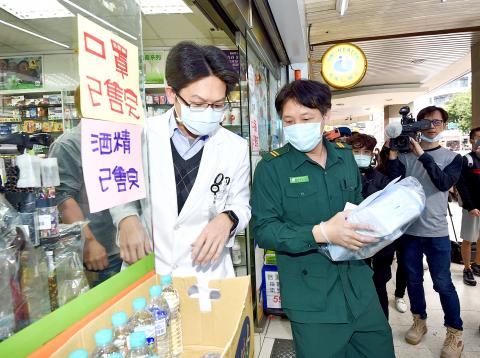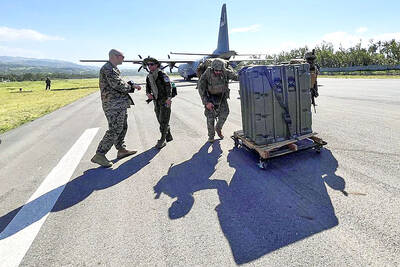About 3,000 Chunghwa Post workers would deliver surgical masks that are to be sold at more than 6,000 locations nationwide starting today, the company said yesterday.
The firm’s workers yesterday began picking up masks from 24 factories in 10 cities and counties and packaged them at various post offices for delivery.
Chunghwa Post has about 7,000 delivery workers on duty each day, Department of Mail Business and Operations head Chen Ching-hsiang (陳敬祥) said.

Photo: Peter Lo, Taipei Times
The Ministry of Health and Welfare has provided a list of 6,515 partner pharmacies and 52 health centers in remote areas to which deliveries are to be made, Chen said.
Each location is to receive 200 masks for adults and 50 masks for children per day, he said.
About 1.6 million to 1.7 million masks would be delivered every day, he added.
Deliveries would be made daily, Chen said, adding that the workload of the company’s employees would be increased and their leaves adjusted.
The Ministry of Labor has informed the Ministry of Transportation and Communications that the policy of giving workers one mandatory day off for every seven days of work might be adjusted for epidemic prevention work, although they cannot be asked to work more than 12 hours per day, Chunghwa Post said.
The company would try to have the adjusted policy apply to its workers delivering the masks, Chen said, adding that although it will be hard work for the employees, they would work hard to cooperate with prevention efforts.
It is facing tight supplies of masks for frontline employees at its post offices, he said, adding that it would work to ensure that they have enough.
While the company is delivering masks to pharmacies and health centers to be sold to the public, it is not responsible for deliveries of masks to medical institutions, he added.
Separately yesterday, asked whether visiting foreigners would be allowed to buy masks, Minister of Health and Welfare Chen Shih-chung (陳時中) said that visitors have not been advised to wear masks, as there is no outbreak of the 2019 novel coronavirus in Taiwan.
The confirmed local cases are mostly people who were infected overseas before returning to Taiwan and the only two indigenous cases are people who were infected by other members of their household, said Chen, who is also head of the Central Epidemic Command Center.
“Therefore, the center does not recommend foreign nationals traveling in Taiwan wear masks, but they can prepare masks and bring them on their own if they are concerned,” Chen said.
As most foreign nationals working in Taiwan are covered by the National Health Insurance (NHI) program, they are eligible to purchase masks at pharmacies with their NHI card, he said.
NHI Administration Director-General Lee Po-chang (李伯璋) said that foreigners residing in Taiwan who have not acquired an NHI card would be allowed to purchase masks at pharmacies with their Alien Resident Certificate or entry-and-exit permit.
The measures would be the same as NHI cardholders: each person can purchase up to two masks every seven days, with people whose residence permits end with an even number allowed to buy on Tuesdays, Thursdays and Saturdays, while those whose permits end with an odd number allowed to buy on Mondays, Wednesdays and Fridays, he said.
Everyone can buy masks on Sundays, he added.

Three batches of banana sauce imported from the Philippines were intercepted at the border after they were found to contain the banned industrial dye Orange G, the Food and Drug Administration (FDA) said yesterday. From today through Sept. 2 next year, all seasoning sauces from the Philippines are to be subject to the FDA’s strictest border inspection, meaning 100 percent testing for illegal dyes before entry is allowed, it said in a statement. Orange G is an industrial coloring agent that is not permitted for food use in Taiwan or internationally, said Cheng Wei-chih (鄭維智), head of the FDA’s Northern Center for

LOOKING NORTH: The base would enhance the military’s awareness of activities in the Bashi Channel, which China Coast Guard ships have been frequenting, an expert said The Philippine Navy on Thursday last week inaugurated a forward operating base in the country’s northern most province of Batanes, which at 185km from Taiwan would be strategically important in a military conflict in the Taiwan Strait. The Philippine Daily Inquirer quoted Northern Luzon Command Commander Lieutenant General Fernyl Buca as saying that the base in Mahatao would bolster the country’s northern defenses and response capabilities. The base is also a response to the “irregular presence this month of armed” of China Coast Guard vessels frequenting the Bashi Channel in the Luzon Strait just south of Taiwan, the paper reported, citing a

UNDER PRESSURE: The report cited numerous events that have happened this year to show increased coercion from China, such as military drills and legal threats The Chinese Communist Party (CCP) aims to reinforce its “one China” principle and the idea that Taiwan belongs to the People’s Republic of China by hosting celebratory events this year for the 80th anniversary of the end of World War II, the “retrocession” of Taiwan and the establishment of the UN, the Mainland Affairs Council (MAC) said in its latest report to the Legislative Yuan. Taking advantage of the significant anniversaries, Chinese officials are attempting to assert China’s sovereignty over Taiwan through interviews with international news media and cross-strait exchange events, the report said. Beijing intends to reinforce its “one China” principle

A total lunar eclipse, an astronomical event often referred to as a “blood moon,” would be visible to sky watchers in Taiwan starting just before midnight on Sunday night, the Taipei Astronomical Museum said. The phenomenon is also called “blood moon” due to the reddish-orange hue it takes on as the Earth passes directly between the sun and the moon, completely blocking direct sunlight from reaching the lunar surface. The only light is refracted by the Earth’s atmosphere, and its red wavelengths are bent toward the moon, illuminating it in a dramatic crimson light. Describing the event as the most important astronomical phenomenon